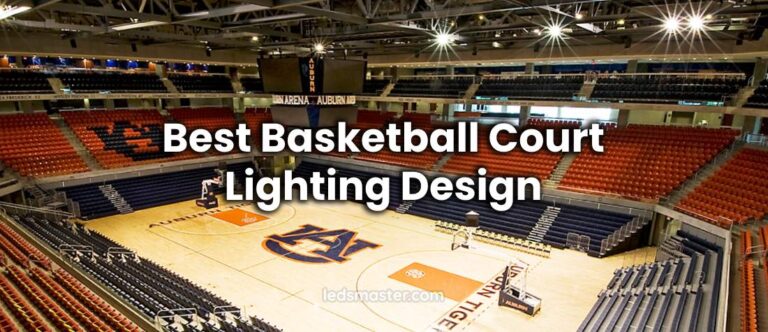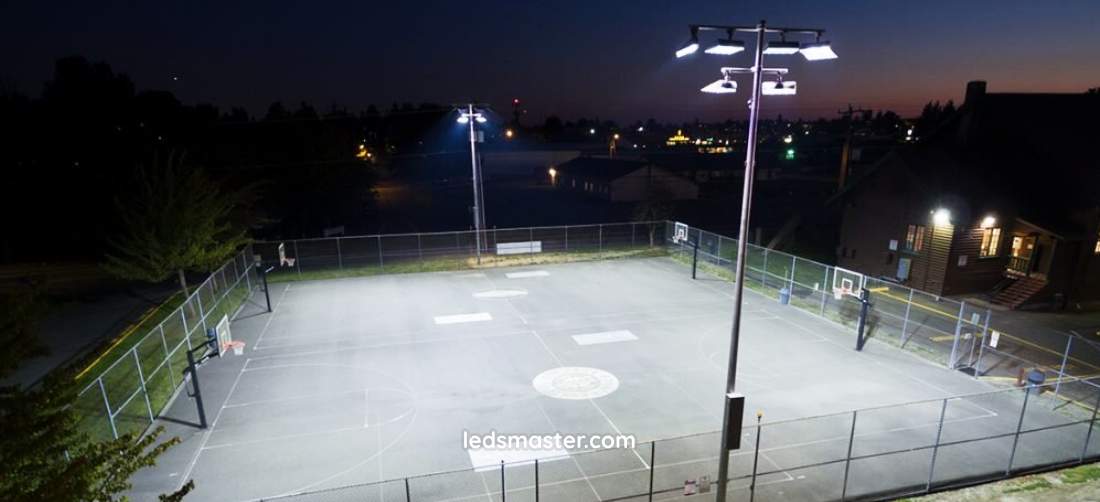
Effective basketball court lighting design is crucial for enhancing visibility, minimizing shadows, and ensuring an optimal playing experience. Whether for indoor or outdoor courts, the right lighting setup can make all the difference. Explore our expert tips and solutions for the best LED lighting design to elevate your game.
Get your complimentary lighting design today
The quality of lighting, whether for indoor or outdoor basketball courts, plays a crucial role in the game. Adequate basketball court lighting enhances visibility, reduces shadows, and ensures that both players and spectators can fully enjoy the experience. This article delves into the nuances of basketball court lighting design, emphasizing the advantages and considerations of using LED lighting for both indoor and outdoor settings.
Table of Contents
ToggleIndoor basketball courts require a carefully designed lighting system to ensure uniform illumination across the entire playing area. The key considerations include the number of lights, their placement, color temperature, and the overall light intensity.
The number of lights needed for an indoor basketball court depends on the size of the court and the lighting fixtures’ specifications. A standard full-sized basketball court measures approximately 28 meters by 15 meters (94 feet by 50 feet). For professional-level play, the recommended illuminance level is around 500 lux, while recreational courts can function adequately with 300-400 lux. To achieve this, typically, 8 to 12 high-efficiency LED fixtures are installed, ensuring even light distribution and minimizing glare.
Proper placement of lighting fixtures is crucial to eliminate shadows and ensure consistent illumination. Lights are generally mounted on the ceiling, positioned symmetrically along the length of the court. It is essential to angle the lights correctly to prevent direct glare into players’ eyes. Additionally, installing lights along the sidelines rather than directly above the court helps in reducing shadows and providing better visibility.

Color temperature significantly affects the visual comfort and performance of players. For indoor basketball courts, a color temperature between 4000K to 5000K is ideal. This range mimics natural daylight, providing a bright and clear environment that enhances players’ ability to see the ball, markings, and opponents. LED lights are particularly advantageous as they offer a consistent color temperature with minimal flickering.
Minimizing glare is essential for indoor basketball courts to ensure players are not distracted or blinded during the game. LED lights with diffusers or anti-glare lenses are recommended to soften the light and reduce harsh shadows. Moreover, uniformity in lighting is critical to avoid areas of high contrast, which can be disorienting for players. A uniformity ratio of 0.6 to 0.8 is considered optimal for indoor courts.
Outdoor basketball courts present unique challenges due to environmental factors such as weather conditions, ambient light, and space constraints. Designing effective outdoor lighting requires robust and durable fixtures that can withstand the elements while providing consistent illumination.
For outdoor courts, the number of lights required is influenced by the same factors as indoor courts, with added consideration for larger areas and higher pole mounting. A typical outdoor court may need 6 to 8 LED floodlights mounted on poles ranging from 8 to 12 meters (26 to 39 feet) in height. The illuminance level for outdoor courts should be around 200-300 lux for recreational play, while competitive levels may demand up to 500 lux.
Outdoor lighting fixtures should be strategically placed to cover the entire court without creating dark spots or excessive glare. Commonly, lights are installed on poles positioned at the corners or mid-sides of the court. The lights should be angled downwards to focus on the playing surface and minimize light spill into surrounding areas. This not only improves visibility but also reduces light pollution.
Similar to indoor courts, the color temperature for outdoor basketball courts should be in the range of 4000K to 5000K. LED lights in this range provide a clear and bright illumination that enhances visibility during nighttime play. Additionally, LEDs are highly energy-efficient, which is a significant advantage for outdoor settings where lights may need to operate for extended periods.
Outdoor lighting fixtures must be durable and weather-resistant to endure various environmental conditions. LED lights with high IP (Ingress Protection) ratings, such as IP65 or higher, are recommended for outdoor use. These ratings indicate that the fixtures are protected against dust and water ingress, ensuring longevity and reliable performance. Furthermore, materials like aluminum and tempered glass enhance the robustness of the lighting fixtures.
LED lighting has revolutionized the way basketball courts are illuminated, offering numerous benefits over traditional lighting solutions such as metal halide or high-pressure sodium lights.
One of the most significant advantages of LED lighting is its exceptional energy efficiency. LEDs consume considerably less power compared to traditional lighting systems such as metal halide or high-pressure sodium lamps. This reduction in energy consumption directly translates to lower electricity bills and a decreased carbon footprint. For basketball courts, which often require extensive lighting for extended periods, this energy efficiency is particularly beneficial. Outdoor courts and indoor arenas hosting multiple games can significantly reduce their operational costs while also contributing to environmental sustainability by switching to LED lighting. The lower energy demand also means less strain on the local power grid, which can be especially important in areas with high electricity usage.
LED lights boast a remarkably long lifespan, often lasting up to 50,000 hours or more. This longevity is a major advantage over conventional bulbs, which typically have much shorter lifespans. The extended operational life of LEDs means that facilities will experience fewer interruptions due to light replacements, leading to reduced maintenance costs and less frequent disruptions. This is particularly important for basketball courts, where consistent lighting is crucial for both practice and competitive play. Furthermore, LEDs are known for their durability and reliability. They are less prone to flickering and degradation over time, ensuring that they maintain consistent performance throughout their lifespan. This consistent performance means that players and spectators can always rely on optimal lighting conditions, enhancing the overall experience.
Unlike traditional lighting systems that often require a warm-up period to reach full brightness, LED lights provide instant illumination. They reach their maximum brightness immediately upon being switched on, which is a significant advantage in sports settings where quick adjustments to lighting conditions may be necessary. This instant on/off capability is particularly useful during games or practices when lighting needs to be adjusted swiftly to accommodate changing conditions or to respond to unexpected events. The immediate response of LED lights ensures that there is no downtime, allowing for a seamless and uninterrupted playing experience.
LED lights are an environmentally friendly lighting solution. They do not contain hazardous materials such as mercury, which is commonly found in older lighting technologies like fluorescent lamps. This absence of harmful substances makes LEDs safer to use and easier to dispose of at the end of their lifespan. Additionally, the energy efficiency of LEDs contributes to lower greenhouse gas emissions. By consuming less power, LED lights reduce the demand for electricity from power plants, many of which still rely on fossil fuels. This reduction in energy consumption helps to decrease the overall carbon footprint of lighting systems, supporting broader sustainability goals. The use of LEDs aligns with environmentally conscious practices, making them a preferred choice for facilities looking to minimize their impact on the planet.
Designing effective basketball court lighting requires careful consideration of several factors, including the number of lights, placement, color temperature, and uniformity. Both indoor and outdoor courts benefit significantly from the use of LED lighting, which offers superior energy efficiency, longevity, and performance. By implementing a well-thought-out lighting design, facility managers can enhance the playing experience, ensure safety, and achieve cost savings. Whether it’s a professional arena or a neighborhood court, proper lighting is essential for making the game enjoyable and accessible to all.